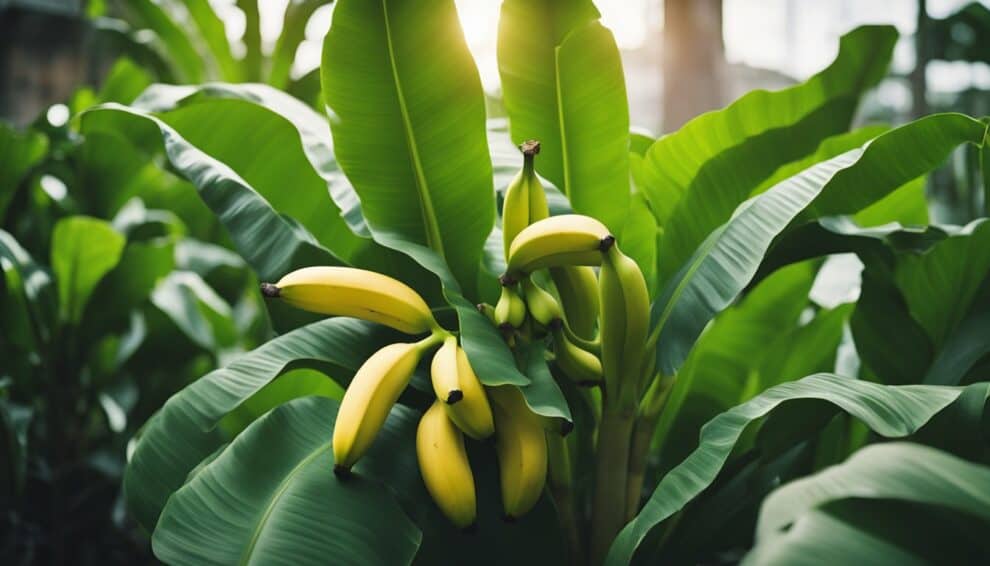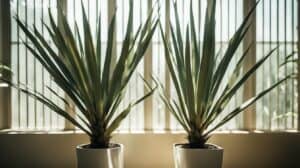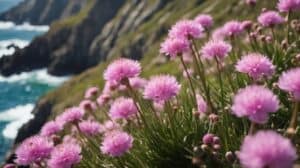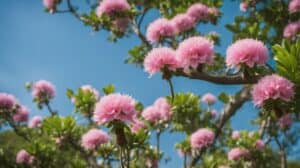Dwarf banana plants are a popular choice for indoor gardening due to their compact size and tropical appearance.
These plants are easy to care for and can thrive in a variety of environments.
However, like any plant, they require proper care to ensure their health and longevity.

For beginners, learning how to care for a dwarf banana plant can seem overwhelming.
However, with a few essential tips, anyone can successfully care for these plants.
This article will provide an overview of dwarf banana plant care, including tips on watering, fertilizing, and pest control.
Whether you’re a seasoned gardener or just starting out, these tips will help you keep your dwarf banana plant healthy and thriving.
Understanding Dwarf Banana Plants
Species Overview
Dwarf banana plants, also known as Musa acuminata, are a type of banana plant that are smaller in size compared to their regular counterparts.
They typically grow up to 6 feet tall and produce small, sweet fruit that is highly nutritious and delicious.
These plants are native to Southeast Asia and are commonly grown in tropical regions around the world.
They are easy to care for and make great additions to any garden or indoor space.
Optimal Growing Conditions
To grow a healthy dwarf banana plant, it is important to understand the optimal growing conditions. Here are some key factors to consider:
- Temperature: Dwarf banana plants thrive in warm temperatures between 75-85°F (24-29°C).
They cannot tolerate temperatures below 60°F (15°C) and may suffer damage or die if exposed to cold temperatures for an extended period of time.
- Light: These plants require full sun or partial shade to grow properly.
They need at least 6-8 hours of direct sunlight per day to produce fruit.
If grown indoors, they should be placed near a south-facing window or under grow lights.
- Soil: Dwarf banana plants prefer well-draining soil that is rich in organic matter. A pH range of 5.5-7.0 is ideal for optimal growth.
Adding compost or aged manure to the soil can help improve its quality.
- Water: These plants require consistent moisture to grow properly.
They should be watered regularly, but not overwatered as this can lead to root rot.
It is recommended to water them deeply once a week or when the top inch of soil feels dry to the touch.
By providing the right growing conditions, anyone can successfully grow a healthy and productive dwarf banana plant.
Planting and Potting
Choosing the Right Soil
One of the most important aspects of dwarf banana plant care is choosing the right soil. The soil should be well-draining and rich in nutrients.
A good potting mix for dwarf banana plants should contain a mixture of peat moss, perlite, and vermiculite.
A pH level of 6.0 to 7.0 is ideal for these plants.
It is important to note that the soil should not be too heavy or compacted as it can lead to poor drainage and root rot.
Adding sand or gravel to the soil mix can help improve drainage.
Selecting a Pot
Selecting the right pot is also crucial for the growth and health of your dwarf banana plant.
The pot should be large enough to accommodate the plant’s root system, but not too large that it retains too much water and causes root rot.
A pot with drainage holes is necessary to prevent water from accumulating at the bottom of the pot.
It is recommended to use a pot with a diameter of at least 12 inches for a mature dwarf banana plant.
When potting the plant, ensure that the soil level is at least an inch below the rim of the pot to prevent water from overflowing.
It is also important to use a saucer to catch excess water that drains out of the pot.
By following these tips for planting and potting your dwarf banana plant, you can ensure that your plant has the best possible start and is set up for healthy growth.
Routine Care

Watering Requirements
Dwarf banana plants require regular watering to thrive. As a general rule, the soil should be kept moist but not waterlogged.
Overwatering can lead to root rot and other problems, while underwatering can cause the leaves to wilt and turn brown.
To determine when to water your plant, check the soil with your finger. If the top inch of soil feels dry, it’s time to water.
It’s best to water deeply, allowing the water to soak into the soil around the roots.
Avoid getting water on the leaves, as this can cause fungal diseases.
Fertilizing Schedule
Regular fertilization is important for the health of your dwarf banana plant.
A balanced fertilizer with equal amounts of nitrogen, phosphorus, and potassium is recommended.
During the growing season (spring and summer), fertilize your plant every two weeks. In the winter, reduce fertilization to once a month.
Be careful not to over-fertilize, as this can burn the roots and damage the plant.
Pruning and Maintenance
Regular pruning and maintenance can help keep your dwarf banana plant healthy and looking its best.
Remove any dead or yellowing leaves as soon as you notice them, as these can attract pests and diseases.
If your plant becomes too tall or crowded, you can also prune it back.
Cut off the top of the plant just above a leaf node, and new growth will sprout from that point.
You can also divide the plant by carefully separating the roots and replanting in a new pot.
With proper care and attention, your dwarf banana plant can thrive and produce delicious fruit for years to come.
Troubleshooting Common Issues
Pest Management
Dwarf banana plants are prone to pest infestations, which can significantly affect their growth and productivity.
Some of the common pests that affect these plants include spider mites, aphids, and mealybugs.
To prevent pest infestations, it is essential to keep the plant clean and free of debris.
Regularly inspect the plant for any signs of infestation, such as yellowing leaves, webbing, or sticky residue.
If pests are detected, it is best to treat the plant with an appropriate insecticide or pesticide.
Disease Prevention
Dwarf banana plants are also susceptible to various diseases, including bacterial and fungal infections.
To prevent the spread of disease, it is essential to keep the plant clean and dry. Avoid overwatering the plant and ensure that the soil is well-drained.
Inspect the plant regularly for any signs of disease, such as yellowing or browning leaves, spots, or wilting.
If a disease is detected, it is best to remove the affected leaves or parts of the plant and treat it with an appropriate fungicide or bactericide.
Addressing Nutrient Deficiencies
Dwarf banana plants require specific nutrients to grow and thrive.
A lack of essential nutrients can lead to stunted growth, yellowing leaves, and poor fruit production.
To address nutrient deficiencies, it is essential to fertilize the plant regularly with a balanced fertilizer.
Nitrogen, phosphorus, and potassium are essential nutrients for banana plants, and a lack of any one of these can affect the plant’s growth.
It is also essential to ensure that the plant is growing in well-draining soil and is receiving adequate sunlight.
By following these essential tips, beginners can troubleshoot common issues that may arise when caring for dwarf banana plants.
Regular inspection, pest management, disease prevention, and addressing nutrient deficiencies can help ensure that the plant grows healthy and productive.
Frequently Asked Questions

How can I create the ideal growing environment for a Dwarf Cavendish banana plant?
Dwarf banana plants thrive in warm, humid environments with plenty of sunlight.
They prefer well-draining, nutrient-rich soil with a pH level between 5.5 and 7.0.
To create the ideal growing environment, ensure that your plant is placed in an area with temperatures between 75-85°F (24-29°C) and humidity levels of 50-70%.
If the air is too dry, consider using a humidifier or placing a tray of water near the plant.
What are the water requirements for a Dwarf banana plant, and how often should I water it?
Dwarf banana plants require consistent moisture, but not overwatering. Water your plant when the top inch of soil feels dry to the touch.
Be sure to water deeply, allowing the water to penetrate the root zone. Avoid getting water on the leaves, as this can lead to fungal diseases.
In general, you should water your Dwarf banana plant once a week, but adjust the frequency based on the humidity and temperature of your growing environment.
What’s the expected timeframe for a Dwarf banana tree to bear fruit, and how can I encourage it?
Dwarf banana plants typically take 1-2 years to bear fruit, depending on the growing conditions and care.
To encourage fruit production, ensure that your plant is receiving adequate sunlight, water, and nutrients.
You can also use a potassium-rich fertilizer to promote fruit growth. Be patient, as it may take some time for your plant to produce fruit.
Could you provide some tips for successfully growing a Dwarf banana plant indoors?
When growing a Dwarf banana plant indoors, it’s important to provide adequate sunlight.
Place your plant near a south-facing window or use grow lights to ensure it receives at least 6-8 hours of direct sunlight per day.
You may also need to adjust the humidity levels in your home to ensure your plant thrives.
Consider using a humidifier or placing a tray of water near the plant. Be sure to also provide consistent watering and fertilization.
Are there any specific benefits to keeping a banana plant inside my home?
In addition to adding a tropical touch to your home decor, Dwarf banana plants can also help purify the air.
They are known for their ability to remove pollutants such as formaldehyde and benzene from the air.
Plus, having a plant indoors can help reduce stress and improve overall well-being.
What are the common signs of improper care in Dwarf banana plants, and how can I remedy them?
Common signs of improper care in Dwarf banana plants include yellowing or browning leaves, stunted growth, and lack of fruit production.
To remedy these issues, ensure that your plant is receiving adequate sunlight, water, and nutrients.
Adjust the humidity levels if necessary, and be sure to check for pests such as spider mites or mealybugs.
If your plant is severely damaged, consider pruning it back to encourage new growth.














